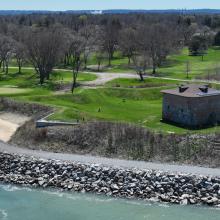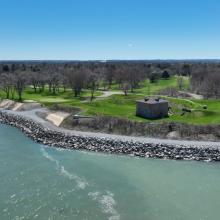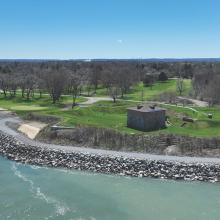Image set


Related services
Related sectors
Related regions
Opening article section
Article section
Rich text
Niagara-on-the-Lake is a bustling, picturesque town located on the shores of Lake Ontario, at the mouth of the Niagara River. Known for its wineries and summer theatre, the town also attracts visitors to the Fort Mississauga National Historic Site, a large, square brick defensive tower set along the Niagara River shoreline.
In recent years, severe climate events have significantly eroded portions of the lake’s shoreline especially along a roughly 400m-long strip of land by the Fort. This portion of shoreline, located by a nearby golf course, had up to five metres disappear causing the slope to destabilize and potentially threaten the integrity of adjacent infrastructures and natural habitats.
Parks Canada, the federal department which manages the Fort, wanted to build a sustainable, cost-effective solution to this erosion problem. Given the lengthy, strong relationship between the Agency and Englobe, the company got the nod to assemble a team of experts from offices across the country to develop a long-term solution.
Rich text
A project with deep cultural and historic importance
Although a portion of the eroded shoreline had been reinforced in 2018, PCA was anxious to protect its remaining historic assets from further deterioration. The Fort Mississauga National Historic Site attracts thousands of visitors every year and is an important example of military construction.
Completed after the War of 1812, the Fort and its central tower were strategically positioned to protect the British/Canadian side of the border and served as a counterpoise to Fort Niagara on the American side. It’s also unique, as it is the only remaining example of this type of fortification - a square tower within star-shaped earthworks – in Canada.
Media
Image set

Rich text
Unique challenges to reinforce slope stability
For this project, the team was tasked with providing tender-ready documents, drawings and specifications, along with engineering services during the tender and construction phases. The team would also offer monitoring and inspection services throughout the construction phase of the shoreline revetment it had designed.
The project’s complexity created unique challenges for the team.
Article quote
Rich text
A cross-country, multi-disciplinary collaborative effort
Gathering the necessary expertise for this project was also a complex task, resulting in a true cross-Canada effort.
- Preliminary analyses completed by Kyle McConnell and the Atlantic team examined the impacts of snow, wind, ice and other conditions on the shoreline.
- Next, Director of Operations Brennan Bailey and his team from Southern Ontario conducted a topographical survey to identify soil conditions and characteristics.
- Then came a geotechnical investigation, handled by Guillaume Joyal, Director of Operations in Quebec, and his team.
- Lastly, Project Engineer Tim Guan led a team of water works experts from MPE, Englobe’s Western subsidiary, who examined all collected data from a hydrology perspective and made recommendations for the shoreline revetment’s design and construction.
Kyle was especially impressed at the collaborative spirit shown by everyone on the project team.
Article quote
Media
Image set

Rich text
Monitoring progress
Curtis Mossman, who worked in Englobe’s Kitchener office at the time, was one of two inspectors responsible for providing administrative support and inspection services during the construction phase, which was awarded to an experienced local contractor.
Article quote
Rich text
The project was substantially completed in spring 2024. Today, this area is protected against a 1-in-100-year climate event, thus preserving the integrity of an important Canadian National Historic Site. Additionally, a new access path created at the top of the protective revetment, originally intended for maintenance purposes, can also be used by pedestrians wishing to enjoy stunning views of Lake Ontario and the Fort.
This project was an outstanding example of the Englobe’s team collaborative spirit and united expertise. These qualities combined to create a sustainable, robust design that will preserve the Lake Ontario shoreline from further erosion and enthrall visitors to Fort Mississauga for decades to come.